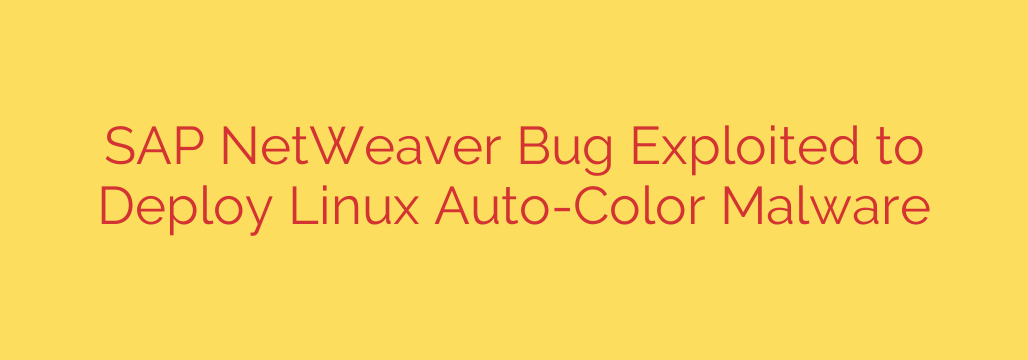
Critical SAP Vulnerability Actively Exploited to Deploy Linux Cryptomining Malware
Cybercriminals are actively targeting a severe vulnerability in SAP NetWeaver Application Server, using it to seize control of enterprise systems and deploy malicious cryptomining software. This campaign highlights a significant risk for organizations running unpatched SAP systems, potentially leading to severe performance degradation, increased operational costs, and a gateway for more dangerous cyberattacks.
If your organization relies on SAP, this is a threat that demands immediate attention. The exploitation of this flaw is automated and widespread, meaning any vulnerable, internet-facing system is a potential target.
Unpacking the Critical SAP Vulnerability
The vulnerability at the heart of these attacks resides within the SAP NetWeaver Internet Communication Manager (ICM), a core component that handles web requests. The flaw allows an unauthenticated, remote attacker to execute operating system commands with the privileges of the SAP service user.
In simple terms, this means an attacker from anywhere in the world can take control of a part of your SAP system without needing any login credentials. This type of vulnerability is considered critical because it provides a direct path for attackers to compromise the server, making it a top priority for malicious actors.
The Attack Chain: From Exploit to Malware
The attack is brutally efficient and follows a clear, automated pattern:
- Scanning: Attackers continuously scan the internet for SAP systems with the vulnerable ICM component exposed.
- Exploitation: Once a vulnerable target is found, the attacker exploits the flaw to gain unauthenticated remote code execution (RCE) capabilities.
- Payload Delivery: The attacker uses this initial foothold to download and execute a malicious script. This script acts as a dropper, responsible for fetching the final malware payload.
- Malware Deployment: The script deploys a specific piece of malware known as “Auto-Color,” which is, in fact, a stealthy cryptominer.
What is the “Auto-Color” Linux Malware?
Despite its innocuous name, the “Auto-Color” malware is a customized version of XMRig, a well-known and powerful cryptomining tool. Cryptomining malware, or “cryptojacking,” hijacks a victim’s computing resources to mine for cryptocurrencies like Monero, sending the profits directly to the attacker.
The impact on an infected server is immediate and significant:
- Severe Performance Degradation: The miner consumes massive amounts of CPU power, slowing down critical business applications and potentially causing system-wide instability.
- Increased Costs: The constant high CPU usage leads to a spike in electricity consumption and cooling costs.
- System Evasion: This malware is designed to be stealthy. It often checks for system monitoring tools and will terminate itself to avoid detection, only to restart later.
More Than Just a Performance Drain: The Deeper Risk
While cryptojacking is a serious issue, it’s often just the beginning. A successful breach of your SAP system is a major security incident that opens the door to far more devastating attacks.
Once attackers have established a presence on your network, they can use that access point to:
- Steal Sensitive Data: Access and exfiltrate confidential business information, customer data, or intellectual property stored within the SAP environment.
- Deploy Ransomware: Encrypt your critical systems and demand a hefty ransom for their release.
- Move Laterally: Use the compromised SAP server as a launchpad to attack other systems within your corporate network.
A cryptominer on your server is a clear indicator that your defenses have been breached and that your organization is exposed to significant risk.
Actionable Steps to Secure Your SAP Environment
Protecting your organization from this active threat requires a proactive and layered security approach. Here are the essential steps you must take immediately:
Patch Immediately and Prioritize: The most critical action is to apply the relevant SAP Security Notes that address this vulnerability. Patch management cannot be an afterthought; it is your primary defense against known exploits. Treat this with the highest urgency.
Minimize Your Attack Surface: Review all SAP systems that are exposed to the internet. If a system does not need to be publicly accessible, place it behind a firewall and restrict access. The less you expose, the harder you are to target.
Monitor for Indicators of Compromise (IOCs): Actively monitor your systems for signs of an infection. Key indicators include:
- Unexplained high CPU usage, especially from unexpected processes.
- Unusual network traffic to or from your SAP servers.
- The presence of unfamiliar files or scripts in temporary directories.
- Unexpected system reboots or application crashes.
Enhance Your Security Posture: Implement a defense-in-depth strategy. This includes using properly configured firewalls, intrusion detection and prevention systems (IDS/IPS), and endpoint detection and response (EDR) solutions that can identify and block malicious activity.
This ongoing campaign is a stark reminder that foundational cybersecurity practices, especially timely patching, are non-negotiable for protecting critical enterprise infrastructure. Waiting to act is not an option when attackers are actively exploiting a known and fixable flaw.
Source: https://www.bleepingcomputer.com/news/security/hackers-exploit-sap-netweaver-bug-to-deploy-linux-auto-color-malware/








